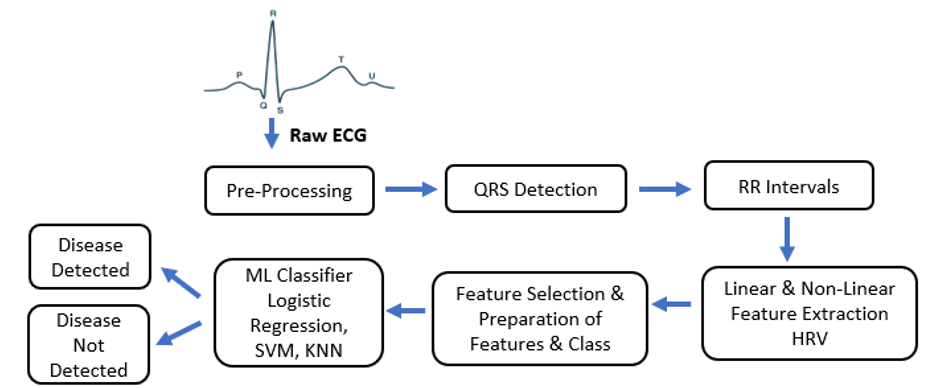Detection of Cardiovascular Autonomic Neuropathy using Machine Learning Algorithms

Keywords:
Diabetes, Heart rate variability , Linear Analysis, Hyperparameter optimization, Machine learning , neuropathy, CardiovascularAbstract
Cardiovascular autonomic neuropathy (CAN) is an asymptomatic and often overlooked complication of Diabetes mellitus (DM). It is found to be more prevalent in Type 2 diabetes (T2 DM) than in Type 1 diabetes (T1 DM). CAN can damage the sympathetic and parasympathetic cardiac and vascular nerve fibers, leading to reduced heart rate variability (HRV) and vascular dynamics. Depression in HRV is an indicator of CAN. Cardiovascular reflex tests (Ewing Test) are currently used as the diagnostic tool for CAN detection, but these tests cannot detect subclinical CAN and require patient cooperation. Therefore, we propose evaluating the feasibility of HRV features (linear and non-linear) over a 5-minute period, embedded within machine learning models to provide a comprehensive screening for patients with CAN. Our study used ECG datasets from PhysioNet, consisting of 100 patients (50 with T2 diabetes and 50 healthy individuals). We applied the Hamilton peak detection algorithm to the ECG signals to detect QRS peaks and extract heart rate signals. Linear and non-linear methods of HRV analysis were used to extract various features from every 5-minute segment of the HRV signal. These features were used to prepare a dataset, and k-fold cross-validation techniques were applied to separate training and testing datasets to make a classification model less biased. For our study, we used logistic regression, K-nearest neighbors (KNN), and support vector machine (SVM) as machine learning classification algorithms. To maximize performance, hyperparameter optimization techniques were used to select the right combination of hyperparameters for each classification model. The highest level of performance was achieved with accuracy measures of 96.67% (logistic regression), 93.33% (K-NN), and 93.33% (SVM), and these were found to be the most significant in the diagnosis of CAN in diabetic patients. The proposed machine learning-based classification models could predict the early onset of CAN and decrease the mortality rate due to myocardial infarction.
URN:NBN:sciencein.jist.2023v11.562
Downloads
Downloads
Published
Issue
Section
URN
License
Copyright (c) 2023 Bhavin Mehta, Vijay Dave

This work is licensed under a Creative Commons Attribution-NonCommercial-NoDerivatives 4.0 International License.
Rights and Permission



